Since its start in 2005, Etsy has been well-known as the place to go for handmade, one-of-a-kind things from a broad array of producers. However, that sunny reputation has shifted a little during the previous several years. That’s why searching for Etsy alternatives has become mandatory for many now.
Many online vendors are unhappy about having to spend more money on things like mandated market strategy and stocking a larger inventory of produced items. Later, in April 2022, Etsy announced boosting seller transaction costs from 5 percent to 6.5 percent.
As a consequence, numerous Etsy merchants went on strike between April 11th and 18th of that year. Yet when the Silicon Valley Bank failed in March, Etsy reacted by withholding fees for certain sellers, which could have been terrible for smaller craft firms.
Not much has changed since then, and many of the same artisans are still wondering whether there is a market for their wares anywhere except Etsy. However, it requires effort, particularly if you’re a relatively tiny seller attempting to get your handcrafted goods noticed in a congested market.
Why Look For Etsy Alternatives?
- Vendors need to differentiate themselves from similar products on the market
Etsy merchants may need help to stand out from the crowd since the site constantly suggests other vendors that provide comparable goods, even while a buyer is already looking at a detailed product page.
A consumer interested in candles, for instance, need only scroll to the bottom of the product page to see “Similar things on Etsy,” a listing of other sellers’ candle offers. Hence, Etsy merchants that invest in a paid campaign will still face competition.
- There is a demand for new advertising channels from sellers
Several of the commonplace practices of online trade are off-limits to Etsy vendors. Nevertheless, marketing tools or Facebook are the only remarketing available on the network, and sponsored advertising is the only way to see your content. Likewise, after a deal has been finalized, sellers are not to contact buyers or request their contact information.
- Vendors seek to diversify their product offerings beyond handcrafted goods
Only antique items, handcrafted items, and craft materials are allowed when it comes to what may be sold on Etsy. As a result, Etsy is no longer an option for merchants who wish to diversify their product offerings into wholesale sales or for those who have found great success on the platform but have needed more time and resources to create each item individually.
- Vendors seek out new sales channels
It’s possible that some Etsy vendors may still use the site, but they’ll also branch out to other online marketplaces to attract a wider audience. Adding other marketplaces where your products may be sold can be a terrific strategy to expand your customer base and get your name out there. Most importantly, it may affect the seller’s bottom line.
- High fees reduce profit margins on sales
Etsy’s listing fee, transaction fee, and payment processing cost are higher than other marketplaces. Due to the cumulative nature of these charges, the platform may become less lucrative for vendors over time, and vendors might choose to use a different platform if it offers reduced costs.
- Competition
Because there are more than 4 million active merchants on Etsy, competition is high. Vendors may find that other platforms provide a less congested marketplace to better stand out from the throng and attract buyers.
- Policy changes disrupt profit estimates and financial goals
Etsy’s policy changes may infuriate merchants whose livelihoods depend on the site’s current rules and regulations. Consider the possibility that other systems will provide higher reliability and consistency.
Top Etsy Alternatives In 2023
Etsy Alternative #1 一 Shopify
Shopify makes it easy to build an online store and start selling to customers all across the world. One of the good things about Shopify is that it’s incredibly user-friendly. Shopify makes it easy to open an online store, even if you have zero experience with either web design or eCommerce. it’s multiple features, such as inventory management, shipping and fulfilment, and marketing tools, make it suitable for operating an e-commerce company.
Shops hosted by Shopify also provide a great deal of customization. You may use Shopify to sell anything from actual things to digital downloads to services. There are also hundreds of other themes and apps to choose from, giving you even more ways to give your company a one-of-a-kind feel.
Shopify, like any ecommerce platform, does not come without its share of charges. The benefits of Shopify’s user-friendliness and support, however, are typically considered as worth the price by many merchants. It can be the right venue to develop your passion into a profitable enterprise.
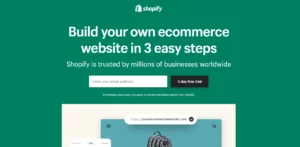
Shopify Pros
- No Selling Fee: First, there are no referral fees or commissions to worry about when you own your shop.
- Total Control: Unlike with Etsy, you have a say over how your products are displayed.
- Access to Customers: Etsy does not provide you access to your client’s contact details.
- Nevertheless, you may use email marketing, SMS marketing, and other promotional methods to bring in recurring customers if you have an online business.
Shopify Cons
- Shopify’s monthly fees: Prices begin at $29 per month
- More upfront setup required: More preparation is needed at the outset: you’ll have to figure out how to use Shopify’s tools to create your website and manage your sales.
- No built-in audience: The third disadvantage is that, unlike Etsy, you won’t automatically have a customer base visiting your site.
Etsy Alternative #2 一 Amazon Handmade
Have you looked into Amazon Handmade if you’re a maker, artist, or craftsperson hoping to sell your wares online? It’s a marketplace where creative types like you can show off and sell your wares to an audience of millions. Having Amazon’s brand and reputation behind Amazon Handmade means that you can rest assured that a broad audience of potential purchasers will view your items.
Amazon has 300 million monthly users, making it the largest online marketplace in the United States. According to research by Statista, Amazon controls 41% of the American e-commerce sector. Moreover, Amazon Handmade provides resources for marketing your items and expanding your business.
This Etsy alternative has a lot going for it; one of them is that it’s pretty simple to use. Stores can be created, items uploaded, and sales initiated with minimal effort. In addition, you can focus on making and advertising your items because Amazon takes care of all the shipping and customer service. Besides these advantages, Amazon Handmade provides several tools to help you stand out from the competition, such as editable product pages, customer reviews, and the option to provide gift wrapping and personalized messages.
In contrast to other online marketplaces, Amazon Handmade does not charge a monthly listing fee, and Amazon deducts a flat 15% referral fee from each sale.
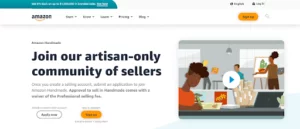
Amazon Handmade Pros
- Built-in audience: Amazon already has a massive user base, so your items will get plenty of exposure.
- Unlimited listings: Second, merchants may list an infinite quantity of items on Amazon Handmade.
- III. No listing fee: Unlike Etsy, where listings cost $0.20 each, Amazon Handmade does not impose a monthly listing fee. Listings are permanent, and Amazon receives payment from makers only when items sell.
- IV. Brand recognition: Consumers know they can shop safely on Amazon since the company has a solid reputation and has security measures to prevent fraudulent transactions. Consumers have higher faith in their ability to make purchases from lesser-known retailers.
- V. Easy delivery: Amazon’s Fulfillment By Amazon (FBA) service handles shipment for you. FBA is an alternative way for sellers to meet demand.
Amazon’s Handmade Cons
- Sign-up required: The application procedure is stringent, and acceptance might take up to 2 weeks, so please be patient while signing up. Sellers with over 20 employees are not eligible to participate in Amazon Handmade.
- Commission: Second, a 15% commission is charged for selling anything on Amazon. This figure is a lot greater than Etsy’s 6.5%.
- Reputation for competitive products: Thirdly, handmade products shoppers only sometimes turn to Amazon because of its reputation for low prices. Amazon’s reputation for selling low-priced, mass-market goods is well-established.
- Limited categories: Amazon Handmade only offers goods in 16 distinct categories, which is a significant drawback. The Amazon Handmade site does not presently provide digital, downloadable, or electronic product categories.
- Lengthy payment cycles: Amazon, unlike Etsy, which pays immediately after each sale, takes two weeks to provide payment.
Etsy Alternative #3 一 Bonanza
Bonanza’s low price makes it a viable option for more expensive shopping cart solutions. Since there are no listing costs and very modest final value fees, you will have more money to reinvest in growing your company. It is not only cheap; it also has a ton of cool features that will make your business shine. With Bonanza’s advertising and search engine optimization (SEO) capabilities, you may reach a larger audience with your wares and attract more buyers.
Bonanza’s community of buyers and sellers is another perk of using the site. You may find and network with other retailers via online discussion groups, social media communities, and other mediums and gain from their insights. Additionally, the Bonanza support staff is recognized for being quick to respond and friendly, which might make selling on the site less hassle.
Naturally, there are restrictions while utilizing this Etsy alternative, just as with any online storefront. It could be less popular or have fewer users than other marketplaces like Etsy or Amazon. Bonanza is only for some, but many vendors have succeeded there thanks to its low costs and valuable tools.
Thus, give this Etsy alternative some severe thought if you’re looking for a new online marketplace to sell your wares. Thanks to its affordable costs, useful tools, and friendly user base, you may have found the ideal platform to expand your business and attract new clients.
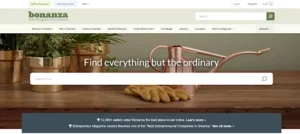
Bonanza Pros
- Low commission fee: Bonanza’s 3.5% selling cost is significantly less than Etsy’s 6.5% commission. A commission-based tier is also available, with Bonanza promoting the seller’s items via channels like Google Shopping.
- Easy product imports: Bonanza facilitates the import of items from other online marketplaces, including Amazon, eBay, Etsy, and Shopify, with no effort on the seller’s part.
- Shipping integrations: The Bonanza platform has shipping connections to link your online store to external shipping providers.
- Build customer relationships: Develop rapport with clients: in contrast to other marketplaces, Bonanza provides vendors with access to client data. This helps retailers form relationships with their consumers and promote a strong brand.
- Merchant-centric: Bonanza lets merchants develop a codeless ecommerce website when they’re ready to make the switch.
Bonanza Cons
- Low traffic and inventory: Bonanza offers few listings and doesn’t draw a broad audience compared to big-name competitors like Etsy and Amazon. To view Bonanza-supported adverts, sellers need to upgrade to higher-tier memberships and give Bonanza a more significant percentage of their sales.
- Inventory synchronization delays: vendors have reported issues with synchronizing their stock from other marketplaces to Bonanza, namely eBay, and Amazon. Bonanza’s and your other marketplaces’ stock totals will only sync up promptly if you sell identical goods on both.
- Low sales: Bonanza’s sellers have complained about poor sales compared to other marketplaces, such as Amazon and eBay. But Bonanza is worth looking into if you’re selling unusual or offbeat items.
Etsy Alternative #4 一 Redbubble
Redbubble, a print-on-demand firm, was launched in 2006 and has already helped 728,000 designers sell their products worldwide. Almost 2 million unique users visit Redbubble monthly to peruse the site’s wacky designs. When artists and designers offer their wares on Redbubble, they have the potential to attract a massive customer base. To get your work looked at, you must sign up for an account and upload it.
Redbubble lets you print your designs on various merchandise, including t-shirts, phone cases, stickers, and more. Once your designs have been uploaded, you can decide which products they will be shown on and at what prices. After your designs have been published and made available for purchase, Redbubble will take care of everything else. Now that printing, shipping, and customer service are taken care of, you can focus on creating new designs and promoting your business.
Each product on this Etsy alternative has a base price, and the seller can choose their profit margin. The standard markup for shops is 20%, although this can be adjusted to suit individual needs. Via its Redbubble Partner Program, the company networks with corporations to grant artists licenses to produce and sell fan art (RPP).
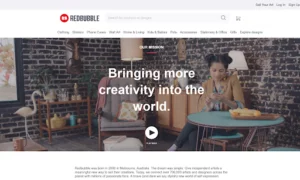
Redbubble Pros
- Good side hustle: Redbubble may be an excellent source of passive revenue for designers because they don’t have to do anything beyond uploading their ideas. The firm handles printing and shipping.
- Easy to use: Redbubble features a user-friendly UI and a simple artwork submission method.
- Unlimited potential: Possibilities are endless; once a design is uploaded to Redbubble, it will remain there indefinitely. As long as the listing is live on the site, the designs have the potential to generate ongoing revenue.
- Large number of items: Redbubble provides more than 60 types of products to print on. Sellers can add their designs to all products or just the ones they want to sell.
- Inventory-free: Redbubble arranges printing and delivery on the seller’s behalf. Printing on demand is a great solution when you need an online shop but want to avoid the hassle of keeping stock on hand.
- No listing fee: Redbubble does not need any listing fees. The designers receive a part of the profits right away.
Redbubble Cons
- No inventory control: Because Redbubble handles everything except design, merchants have little say over the quality or quantity of inventory regarding product material or print quality.
- Long payment cycle: Payments are delayed on Redbubble; artists only get paid on the 15th of every month, while Etsy sends out payments immediately.
- High competition: Since using Redbubble to sell your wares doesn’t cost you anything, there is a lot of competition. To separate from the crowd, designers must create innovative and fashionable looks.
- No relationship management: Because Redbubble doesn’t provide any information about its users, it’s hard to develop a rapport with them.
Etsy Alternative #5 一 eBay
If you’re looking for a place to buy or sell almost anything online, go as far as eBay, one of the biggest and best-known online marketplaces. Setting up a shop to sell on eBay is simple; sign up for an account and post listings. You can sell products in either an auction or a fixed-price arrangement and determine your own prices and delivery costs.
One of the many advantages of selling on eBay is the site’s massive and varied customer base. This Etsy alternative’s massive user base means your products have a global audience. In addition, eBay provides services that may be used to advertise your listings and bring in additional customers.
EBay’s flexible payment methods are a major perk for buyers and sellers. eBay provides tools to assist you in managing your transactions and tracking your revenues, regardless of whether you want to accept payments by PayPal, credit card, or some other way.
Like any other online marketplace, selling on eBay does come with a few costs. The selling price of an item on eBay is deducted from the buyer’s final payment, and the site also has additional fees for services like featured and upgraded listings and auctions. But, for many vendors, the potential for more revenue and publicity is worth the effort.
In other words, consider using eBay if you want to sell anything online. It is a fantastic platform for expanding your business and reaching new consumers due to its vast user base, varied payment choices, and wealth of available tools and information.

eBay Pros
- Built-in audience: Like Amazon, eBay has a big in-built audience. Sellers may access customers across the world.
- Brand recognition: eBay is the third-largest ecommerce store in the US with the established brand authority. Consequently, customers are eager to buy from unknown firms in their marketplace.
- Flexible listing: Sellers can offer their items in an auction-based or fixed-pricing listing. Collectibles benefit greatly from auction-style listings, whereas fixed-price ads best serve ordinary things.
- Convenient shipping: eBay works with a network of shipping partners to make it simple for sellers to ship their wares to customers worldwide.
- List used items for sale: As long as the ad specifies that they are used, eBay sellers can offer them for sale.
- Timely payment: Sellers can opt to get paid either daily or monthly.
eBay Cons
- Extra fee: A one-time fee of $0.35 for listing items on eBay. When an item sells, the seller must pay a commission of 10% to 15% of the sale price.
- Piracy: Although eBay has relationships with law enforcement to prevent piracy, counterfeit items are still on the marketplace.
- Listing limit: New sellers have a listing limit of 10 goods valued at up to $500 monthly.
- Cheap pricing: Because of its low prices and excellent reputation, eBay is the premier online marketplace for anyone seeking a good deal. As a result, businesses feel the need to provide free delivery and reduced prices.
Etsy Alternative #6 一 Ruby Lane
Since its launch in 1998, Ruby Lane has become a leading online vintage marketplace. Daily sales on Ruby Lane total over $125,000 thanks to the almost 2,000 vendors that call it home. Ruby Lane is known for its unique pottery, carpets, lamps, jewelry, dolls, and apparel.
Ruby Lane’s average customer appreciates the finer things in life, has an eye for originality, and has a taste for luxury. There is no need for worry on either side of the transaction because the platform offers reliable and secure delivery and payment methods.
Besides specializing in antiques, Ruby Lane is well-known for its meticulously detailed photographs and descriptions of its wares. According to the platform’s rules for item descriptions, capturing high-quality photographs might help your products stand out from the competition and attract more buyers.
A wide variety of products, including art, jewelry, and furniture, can be shown and sold on this Etsy alternative. The marketplace also provides various resources to help sellers determine reasonable prices for their products.
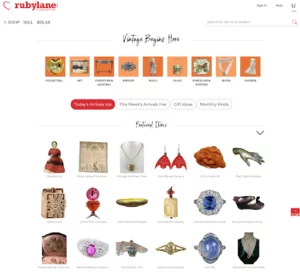
Ruby Lane Pros
- Targeted audience: Ruby Lane draws high-end shoppers who enjoy antiques, art, and collectibles. Compared to other online marketplaces, the average product price is greater.
- Service fee: Ruby Lane’s service fee is 6.7% of the total purchase price with a minimum charge of $250.
Ruby Lane Cons
- Limited audience reach: Ruby Lane is a specialized online store that caters to a certain sort of client.
- Maintenance fee: Keeping 50 things in good condition costs $54 each month. Depending on how many products are listed, the maintenance price increases from $0.30 to $0.10 per item after the initial 50.
- Delayed payment schedule: Thirdly, a delayed payment system is in place, with vendors receiving their money on the first of the month.
- Outdated website: Inadequate filtering and an out-of-date user interface characterize Ruby Lane’s website, a major drawback.
Etsy Alternative #7 一 Cratejoy
Have you considered Cratejoy Marketplace, an online community for subscription box entrepreneurs? Cratejoy Marketplace is an online platform that acts as a market for subscription boxes, where subscribers may browse and buy products from many vendors.
Signing up for an account on Cratejoy Marketplace and listing your subscription box for sale is simple. There is a commission fee for each sale made via Cratejoy, but no other fees are associated with utilizing the site.
Cratejoy Marketplace attracts a niche demographic of people interested only in purchasing subscription boxes. Suppose you have a unique or specialized subscription box to sell. In that case, Cratejoy Marketplace may be a fantastic venue to reach a highly engaged audience because of the sheer number of people that visit the site who are enthusiastic about trying new things via subscription boxes. You can easily keep tabs on stock levels and orders, organize your clientele, and sell your subscription service.
Overall, selling on Cratejoy Marketplace may be a fantastic method for businesses to access a highly engaged community of subscription box fans and expand their brand. This Etsy alternative is sure to give you profitable returns!
Suppose you want to sell your subscription box online. In that case, you should check out Cratejoy Marketplace because of its subscription box emphasis, tools and resources to assist in running your company, and easy-to-use platform.
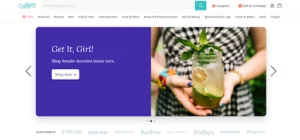
Cratejoy Pros
- No listing fee: There is no listing cost on Cratejoy.
- Fraud protection: Cratejoy ensures the security of its customers’ financial information by employing anti-fraud measures.
- Third-party fulfillment: Cratejoy supports third-party fulfillment systems such as ShipStation and Pirate Ship.
- Website builder: Cratejoy, a site builder, assists businesses in creating a website without coding knowledge for a monthly fee of $39. Every transaction completed on the website or marketplace incurs a 1.25% + $.10 commission fee.
- Multiple categories: Cratejoy gives vendors various niches to select when designing their subscription boxes.
Cratejoy Cons
- Fees per sale: Cratejoy charges a fixed 1.25% fee on the selling price and an extra $0.10 transaction fee.
- High competition: Cratejoy’s platform’s popularity means stiff competition from other subscription box providers.
Etsy Alternative #8 一 Instagram Shopping
With Instagram’s new Shopping function, companies can sell their wares without leaving the app. You may shop without ever leaving the app, which makes for a convenient and easy purchasing experience for consumers. Creating a Facebook Shop and linking it to your Instagram business account is all you need to do to get Instagram Shopping up and running. Upon verification, you can tag goods in your Instagram posts and stories so that users can easily view further information about them and make purchases without leaving the app.
Instagram Shopping’s huge user base of over a billion monthly active users is only one of its many strengths. If you have a visually appealing product or business and are trying to reach people enthusiastic about trying new things, Instagram is a terrific place to employ.
Instagram isn’t only a great place to look for innovative products; it’s also a great place to get tools and resources to help your business expand its online presence. From ad production and management to CRM and sales data tracking, this Instagram marketing platform may meet your every need. Each party involved in a transaction on the platform can feel at ease knowing that their financial data is being handled securely.
Taking advantage of Instagram’s lively and massive user base can help brands expand their audience and forge deeper connections with potential customers.
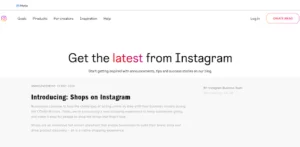
Instagram Shopping Pros
- Wide audience: Instagram has a massive user base, which means more exposure for your company’s products.
- Use of hashtags: Second, Instagram allows businesses to reach their target audience through the use of hashtags, stories, posts, and advertising.
- Friendly UX: Third, we have streamlined the user experience by making it possible for Instagram users to make a purchase without leaving the app.
- Simple checkout: Instagram shopping is more alluring than ever now that they have simplified the checkout process.
Instagram Shopping Cons
- Selling fee: Instagram’s selling fee is a flat 5% for each shipment Sales tax, and processing costs have been included in this price.
- Location restrictions: Instagram Checkout is now only accessible within the United States. Nonetheless, expansion to other nations is planned.
- Lack of relationship management: Thirdly, sellers have difficulty connecting with buyers since they get shipping information.
- Lack of ecommerce features: Instagram needs to have standard e-commerce tools like cart abandonment or email marketing.
Conclusion
Etsy is a fantastic platform to launch your business, get traction, and refine your offering to the point where it’s ready to take on the world. Yet, there comes a time when one must decide whether or not to proceed. If you’ve outgrown your Etsy store, that’s a great sign! It shows that your company is thriving and expanding. This is when you can search for Etsy alternatives.
Adding a personal website or marketplace to your existing Etsy store is a good method to test the waters, so long as you pay close attention to the analytics of your visitors and marketing initiatives. Many Etsy sellers who later moved to Shopify decided to leave their stores up, giving both platforms more potential customers. Choose from the list of Etsy alternatives because they are the best-sellers of 2023.
FAQs
Do rivals to Etsy provide better prices?
To what extent a seller discounts their goods is entirely up to them. Getting similar or even better prices at some of the many Etsy rivals is possible. To get the best price, you should compare offerings.
Is the demand for Etsy Alternatives as high?
While Etsy has the lion’s share of the handmade marketplace business at the moment, some of the other options have also built up large user bases. Not all merchants will thrive in a large, competitive marketplace; some will operate in a more intimate setting.
Can the same items be listed for sale in different online stores?
As long as you follow each marketplace’s guidelines, you can sell the same items on more than one. Overselling can be avoided if stock levels and sales figures are monitored regularly.
Where else, except Etsy, might I sell digital products?
You may offer digital things like artwork, patterns, and printed materials on platforms similar to Etsy. Digital items may be allowed on some media, but verifying this with the platform in question is vital.



